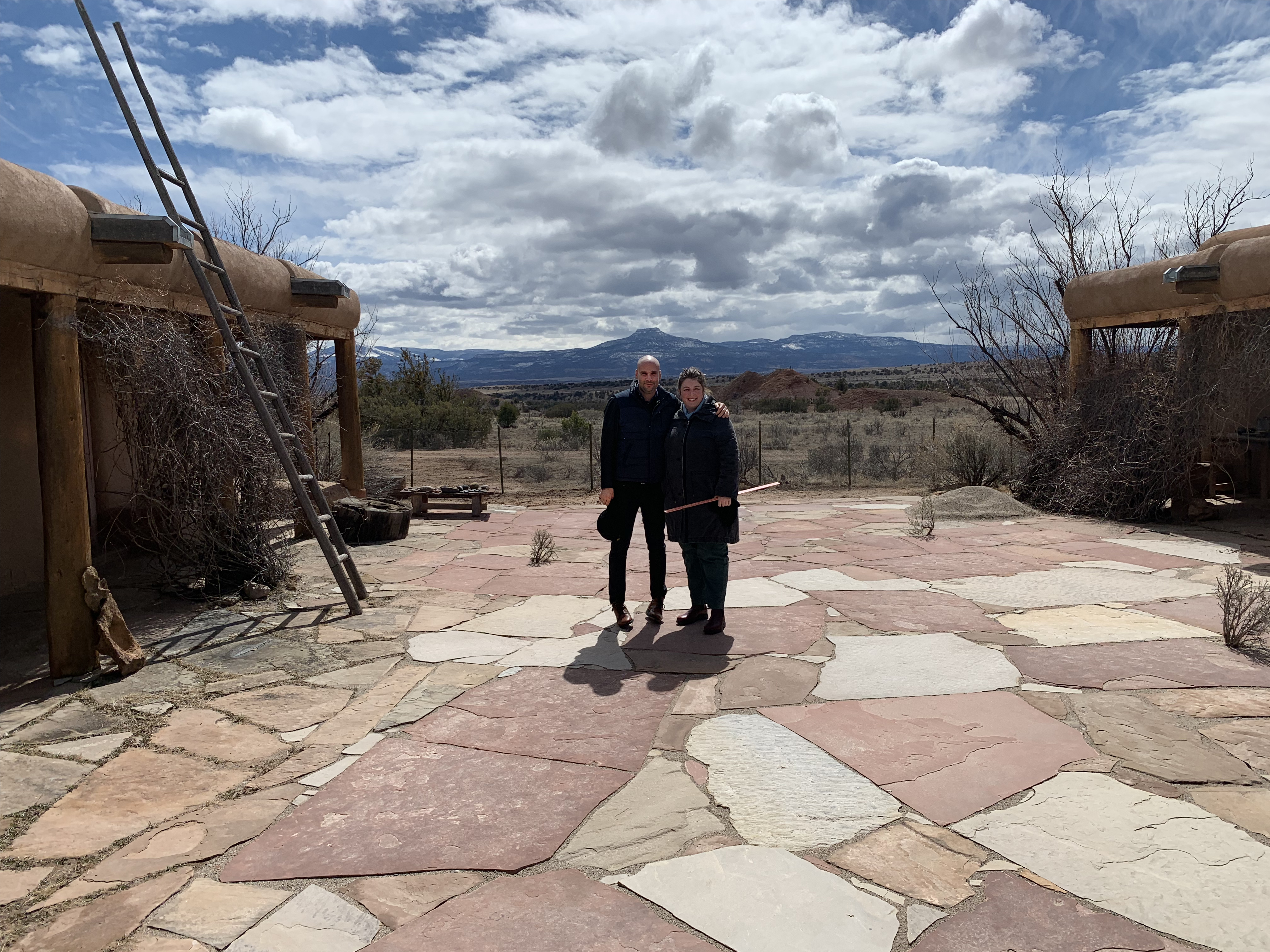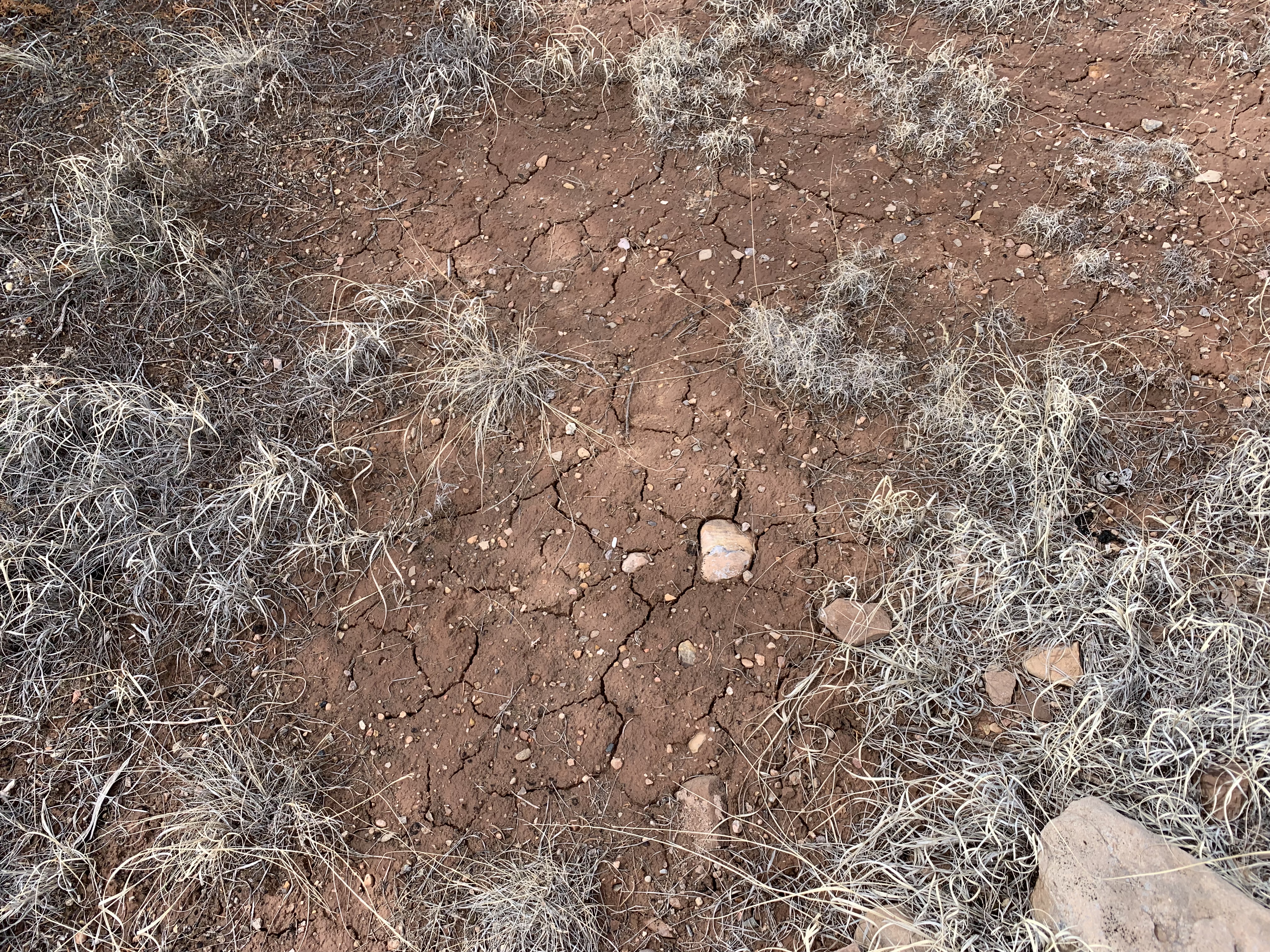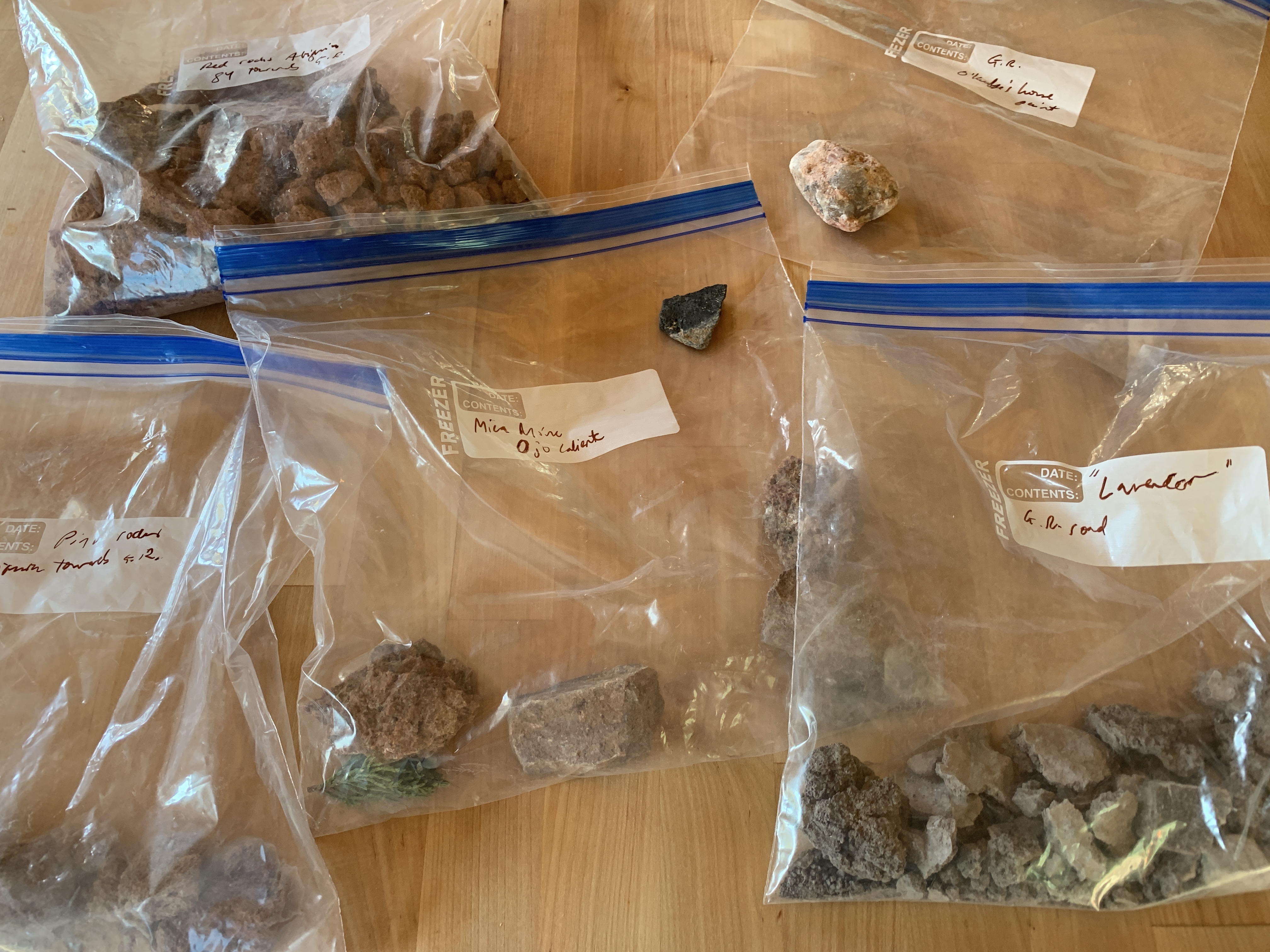Conversation with the Artist
- Ariel Plotek, Curator of Fine Art, Georgia O'Keeffe Museum
- Josephine Halvorson
Ariel Plotek: A single-artist museum, like the O’Keeffe, is a special kind of institution. What did you first think, when you imagined an artist residency in partnership with the Georgia O’Keeffe Museum?”
Josephine Halvorson: Well, funnily enough, I thought of Vincent Van Gogh. He’s the subject of another single-artist museum. There are similar mythologies at play, the larger-than-life personas. When we think of O’Keeffe in Abiquiú, or Van Gogh in Arles, so much of what comes to mind has to do with place. Their best-known work seems to have been made in certain landscapes, and so too were their personas. And when I think about the present, about contemporary art, I’m drawn to artistic practices that exist in relation to regional specificity. For me it’s something that I also associate with painting, a sort of grounding materiality.
Much of what we know about Van Gogh’s life and work comes from his correspondence with his brother Theo. It’s a little like O’Keeffe and her letters to Alfred Stieglitz. Like Van Gogh, she was able to exile herself, to work far from any major commercial center for a period of her life. And, because both artists had someone else—someone representing their interests elsewhere—they were more readily able to lose themselves in their work for a period of time. However, the Van Gogh Museum is situated in the metropolis of Amsterdam, whereas the O’Keeffe Museum in Santa Fe invites visitors to travel to a region that has become synonymous with her paintings.
It’s interesting that people continue to make pilgrimages to places like Santa Fe and to her house in Abiquiú. We still travel in real time to see real works of art. Today at Ghost Ranch tours are regularly given to visitors on horseback or in buses to match reproductions of O’Keeffe’s landscape paintings with the actual spots depicted in them.
Lately we’re so decoupled, it seems to me, and in so many ways, from the physical world, whether socially, economically, technologically. But if you look at O’Keeffe, and the relationship between the objects that she made and the objects that she surrounded herself with—it’s all of a piece. Her values were the same, outside the walls of her studio, or inside the corners of her paintings.
I suppose some of that identification, between the art and the life, must have been forged fairly early on. I mean, how could O’Keeffe ever separate out the image of herself from her art, when Stieglitz exhibited his photographs of her alongside her paintings for her first exhibition in New York City?
AP: But she did outlive Stieglitz. And, in time, she got to tell her own story.
JH: Yes, she certainly did. And she had longevity, having lived well into her nineties. I was struck by how O’Keeffe concerned herself with posterity and her own mortality, how she grew, as it were, into her own image. She is kind of immortal. I mean, today there’s a Georgia O’Keeffe Museum! For there to be an institution dedicated to the life of a woman, for attention and care be given to her things and her vision, it’s profoundly important and moving. I listened to an interview she gave towards the end of her life where she said something along the lines of ‘I could have made better paintings, but no one would have cared. It was my person that interested them more than my art.’ I found this telling, yet complicated. It opens up all kinds of questions about the expectations society has of artists, the changing nature of public and private life, gender and culture, and much else. I’m still thinking about this and will for a long time to come.
AP: And you’ve had the opportunity, since, to return to New Mexico.
JH: When I returned to New Mexico to continue painting a year after my residency, I began to reflect more deeply on this issue of lifespan and memorialization. During that visit I came across a site with fragments indicating the locale of a former Native American settlement. Painted pottery shards revealed themselves in the earth, literally washing away.
Along with my painting of the archeological remnants, I found myself painting other objects, notably two signs, clinging to the present. One indicated the boundary of the Santa Fe National Forest, shot through with bullets. Another was from Santa Rosa de Lima, an 18th century abandoned adobe church in Abiquiú. These paintings were made during the summer of 2020 during a transformative and turbulent time in the U.S. where so much was—and remains—at stake. Covid was stealing lives, including my own father’s, and I suppose my paintings started to take the form of memorials. I want my paintings to remember more than I ever can. And this issue of memory, whether within a family or an institution or a culture, weighed on me while making this work. I found myself asking what gets remembered and what doesn’t.
AP: Yes. And this makes me think of our conservation department, and how their mission really is to “halt” time. And that’s a tall order. And it makes me think also of the bones and skulls that O’Keeffe collected and painted—objects we commonly associate with death, or at the very least the passage of time.
JH: Yes, O’Keeffe and I are both interested in still life, vanitas, and memento mori—genres within art that are a reflection on life and its inevitable end. O’Keeffe is not just a historical figure for me, though, when I recall that our lives overlapped by a few years in the early 1980s. She used the same shampoo that I did, for instance, and created shelving out of wooden fruit crates, just like the ones my mother built in my childhood home. She had some of the same art books I do and subscribed to magazines that are still in print. Honestly, it was strange to be surrounded by the ghosts of a consumer culture that belonged to my younger self—and to see them preserved in perpetuity.
AP: Yes, that’s true for me as well. And what do you suppose your earliest memory is—when you first recall being introduced to O’Keeffe?
JH: Do you know, it’s hard to remember, because she’s been a presence for so long. I can hardly recall the first time I learned who she was because she’s always figured in my imagination of what it means to be an artist and an independent woman. As my life has unfolded, it seems we share some similar biographical outlines.
The residency forced me to renegotiate and reconsider who I’d imagined O’Keeffe to be, and see her in more dimensional ways. It was interesting, and complicated, and enlightening. So much has been projected onto her, by so many people, including, of course, myself.
I remember throughout my childhood into my adolescence—and to this day—feeling identified with O’Keeffe and her paintings. As a teenager, I remember listening to the Nields’ song “Georgia O” a third wave feminist anthem, and feeling powerful kinship. And, looking further back, I remember an activity in elementary school art class that probably introduced me to O’Keeffe—we painted flowers. Who I am today, what I choose to do and make as an artist, is undoubtedly influenced by O’Keeffe.
AP: And now, in some sense, the tables have turned—it’s you who’s been a presence in O’Keeffe’s space.
JH: Yes, I felt seen in her space. I also felt present in a temporal sense. I was given a finite amount of time to work there and there was only so much that I could accomplish during the daylight.
It reminded me of working in Rome at the Villa Medici several years ago. I spent a calendar year there as a fellow and was highly attuned to the various durations of time. It was an extraordinary privilege, and quite challenging, to make art in Ingres’ former studio, a studio which was also home to dozens of other artists over the two centuries in between. The thought of making something new in that space, one that presided over “the eternal city”, was actually quite overwhelming.
And then, at Ghost Ranch, I had the voices of the museum staff in my head—all the rules about how and how not to be in this precious space. And that inescapable presence of O’Keeffe, amplified through her home, all while knowing how she herself could be quite proprietary. It made me feel like I was trespassing in some ways. Trespass is something difficult to avoid in my practice. After all, making paintings on site, en plein air, always involves a prolonged visit to a particular place, and even when I’ve made work on my own land in Massachusetts, I feel like a visitor. My practice inevitably opens up many questions of ownership and belonging.
After painting I try to leave without a trace. I almost never touch my subject or displace anything around me, except for the ground beneath my feet. Over the last several years I have been gathering a few rocks and debris from the general vicinity underfoot. I then have been incorporating them into frames for the paintings, a kind of surroundings to contextualize the painting.
AP: That’s been the case with these paintings as well—the ones in the exhibition at the Georgia O’Keeffe Museum. Tell me a little more about that practice, and the materials you’ve moved to as you moved away from oil on linen.
JH: Oil was my medium of choice for a decade or so. Many of those paintings were made slowly over the course of a long day or two, where I worked while the paint was wet and stopped when the surface formed a skin. My working time was akin to a curing period, like when you make a cast. Painting felt like taking an impression of not just what I was looking at, but of the time and place as well. I was interested in the way that painting could congeal experience, materially and metaphorically.
At a certain point I noticed my work, which primarily concerns itself with how to transcribe reality, was taking on a verité quality—the painterly equivalent of a single take and photographic exposure. I wanted to work with materials—both the paint and the support—to record my observations in real time. I started to work more indelibly, using highly pigmented water-based paints that could soak into an absorbent ground. With oil paint I could wipe away and revise my decisions, but with acrylic gouache my strokes were permanent. This way of painting shares something with fresco, examples of which I had studied in Italy and learned to use when I was teaching at Skowhegan, a school in Maine that continues to teach this ancient technique.
My newer approach has taken on more significance in the last several years as we live in a “post-truth” culture. The more challenges to trust I encounter, the more I am drawn to making paintings-as-facts. I’ve been asking myself what is a fact, what is a reliable source, what constitutes belief? Describing what I see in real time, undeniable through my own notations, allows me to create a subjective account of something that exists. By incorporating “real” site material into the surrounding frames, I hope to add not just context but objectivity as well. I think of this material as evidence of place, geologically speaking. Together, the painting and its surround hopefully offer a testament to something having existed, and to my ability to notice it.
AP: Speaking of new materials and techniques, you’ve been experimenting with photography. How has that informed your practice as a painter?
JH: Photography has definitely informed my thinking, especially around ideas of authenticity and truth telling. I’m fascinated in particular by the tradition of the photo essay—something that really doesn’t exist in painting. I’ve always written alongside my painting practice,and would like to find a way to integrate that writing into the work somehow. By using screen-printed iconography and imagery in the margins of my paintings—the faces or edges of the surrounds—I’ve found a way to incorporate language into the picture. But paintings are still expected to sort of “speak for themselves,” and I think my paintings may have more to say.
AP: You were speaking a moment ago about language, and it makes me think about the ways in which you’ve incorporated “found” text into your paintings. And how all of your still lifes are really “found” subjects of one kind or another—how we feel like you yourself haven’t moved a thing.
JH: Yes. I think you can tell right away when a subject’s been arranged. We know it when we see it. For instance, a few years ago, I was making a painting of the ground and someone stepped on the patch of ground I was describing. I had to put the leaves back where they were, using my painting as a guide. I found a nearby red leaf that hadn’t been there previously and thought it would add something aesthetically to the painting, so I moved it in. Forever, that painting will look false and contrived to me.
When painting everyday life, there’s an obligation, or at least an assumption, that a found subject mustn’t be composed. You’re supposed to catch it in a sort of candid way, perhaps one more associated with the instantaneity of the photograph. I’m thinking now of my painting of sticks that I made just above the Rio Chama. I spent several days on that piece and each night I would go to bed and hear the strong winds, convinced the sticks were going to be gone by morning. So I have to make room for that element of chance, or luck, or disappearance, which ultimately contributes to the work.
| words



